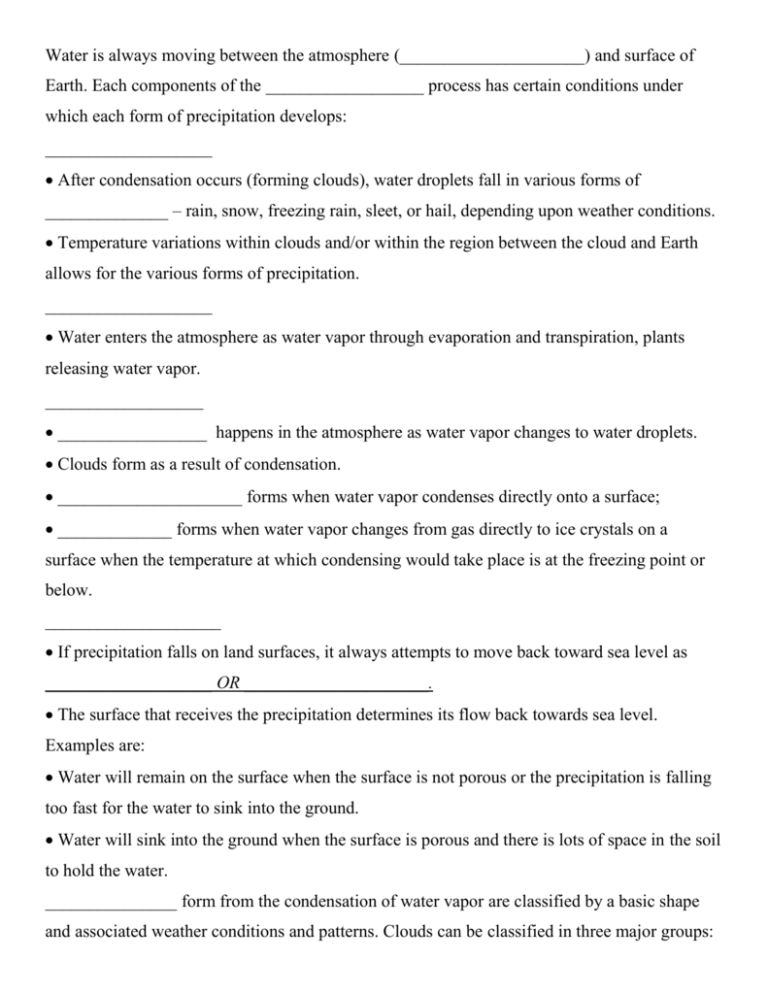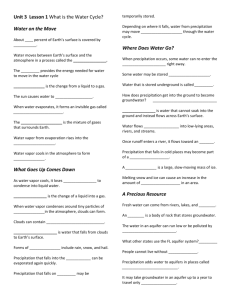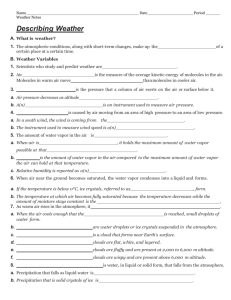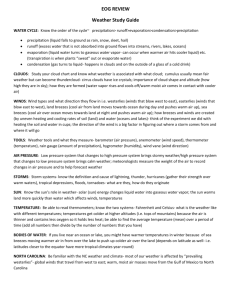6-4
advertisement

Water is always moving between the atmosphere (_____________________) and surface of Earth. Each components of the __________________ process has certain conditions under which each form of precipitation develops: After condensation occurs (forming clouds), water droplets fall in various forms of ______________ – rain, snow, freezing rain, sleet, or hail, depending upon weather conditions. Temperature variations within clouds and/or within the region between the cloud and Earth allows for the various forms of precipitation. Water enters the atmosphere as water vapor through evaporation and transpiration, plants releasing water vapor. _________________ happens in the atmosphere as water vapor changes to water droplets. Clouds form as a result of condensation. _____________________ forms when water vapor condenses directly onto a surface; _____________ forms when water vapor changes from gas directly to ice crystals on a surface when the temperature at which condensing would take place is at the freezing point or below. ____________________ If precipitation falls on land surfaces, it always attempts to move back toward sea level as ___________________ OR _____________________. The surface that receives the precipitation determines its flow back towards sea level. Examples are: Water will remain on the surface when the surface is not porous or the precipitation is falling too fast for the water to sink into the ground. Water will sink into the ground when the surface is porous and there is lots of space in the soil to hold the water. _______________ form from the condensation of water vapor are classified by a basic shape and associated weather conditions and patterns. Clouds can be classified in three major groups: ___________________ Clouds formed at medium or low elevation. Cumulus clouds are puffy with flat bottoms. When cumulus clouds are white they often signal fair weather, but when they are darker, they may signal rain or thunderstorms. __________________ Clouds formed at high elevations; wispy clouds usually consisting of ice crystals that signal fair weather or may also signal an approaching warm front. ___________________ Clouds formed at medium or low elevation; spread out layer upon layer covering a large area As stratus clouds thicken, precipitation usually occurs over that area. The names of many clouds are a combination of one of the three basic shapes and a prefix or suffix. The basic shape name can be combined with the appropriate prefix or suffix listed below as clues to the weather conditions that may result. Combinations of those shapes can be used with __________, which means “rain”, for example, cumulonimbus or nimbostratus. A ___________________ cloud, also called a thunderhead, is often part of thunderstorm conditions that may accompany a cold front. The prefix __________- may also be used to indicate medium-level clouds formed at about 26 kilometers up into the atmosphere, for example, altocumulus or altostratus. Clouds that form when condensation occurs at or near the ground are called fog. Interactions between ___________________, __________________, and _______________ _________________________result in various weather conditions. _________________________ Air masses are huge bodies of air that form over water or land in tropical or polar regions. Temperature and humidity conditions (for example, warm or cold air, humid or dry air) within the air masses as they form are important to the resulting weather conditions when air masses move. ________________________ As these air masses move and collide with each other, fronts form at the boundaries between the air masses. Depending upon the air masses involved, a warm front, cold front, stationary front, or occluded front can develop. When a warm air mass collides and rides over a cold air mass, the resulting _______________________may produce long periods of precipitation and warmer temperatures. When a cold air mass collides and slides under a warm air mass, the resulting ________________________may produce thunderstorms and sometimes tornadoes and cooler temperatures. When neither a cold air mass nor a warm air mass moves at a frontal boundary, the resulting __________________________ may produce long period of precipitation. When a cold air mass pushes into a warm air mass that is behind a cool air mass, the warm air mass is pushed up above the cooler air masses. The resulting __________________________ may produce long periods of precipitation. High/Low Pressure Systems Warm air rising or cold air sinking combined with the spinning of Earth causes the air to spin forming high and low pressure regions. ___________________________usually signal more fair weather with winds circulating around the system in a clockwise direction. ___________________________with counterclockwise circulating winds often result in rainy and/or stormy weather conditions. ________________ Severe weather conditions called storms occur when pressure differences cause rapid air movement. Conditions that bring one kind of storm can also cause other kinds of storms in the same area. ______________________is storm with thunder, lightning, heavy rains and strong winds; form within large cumulonimbus clouds; usually form along a cold front but can form within an air mass. ______________________ is a rapidly whirling, funnel-shaped cloud that extends down from a storm cloud; the very low pressure and strong winds can cause great damage to people and property; are likely to form within the frontal regions where strong thunderstorms are also present. _____________________ is a low pressure tropical storm that forms over warm ocean water; winds form a spinning circular pattern around the center, or eye, of the storm; the lower the air pressure at the center, the faster the winds blow toward the center of the storm. MUST BE ________ MPH WINDS! Other Weather Conditions Since weather is a condition of Earth’s atmosphere at any time, weather conditions may include fair weather, showers or light rain, humid conditions, clear skies with cold conditions, days of clouds and precipitation, or others that do not necessarily involve storms. ________________ A tool used to measure wind speed in miles per hour. __________________ A tool used to measure wind direction. Sometimes referred to as a wind-weather vane or a wind sock. Wind direction is described by the direction from which the wind is blowing. __________________A tool used to measure air temperature in degrees Fahrenheit or Celsius. ____________________________A two-thermometer instrument also referred to as a wet-dry bulb used to measure ____________________________(the amount of water vapor in the air). Temperatures readings are converted using a relative humidity table. ________________ A tool used to measure air pressure in inches of mercury or millibars (mb). _________________ A tool used for measuring the amount of precipitation in inches or centimeters. Weather conditions and patterns can be predicted based on weather data collected from various sources. Direct Observations and Measurements Basic weather conditions can be observed and/or measured by________________________ at national weather data collection sites. In order to make weather predictions, the data should be collected on a regular basis over a period of time. This allows for the development of patterns in weather conditions from the analysis of the data. For example, a hurricane’s path can be predicted using data on its position over time (plotted on a hurricane tracking map), thereby allowing meteorologists to make predictions concerning the possible warnings to land areas in the hurricane’s path called ________________________ Weather maps Weather maps can help predict weather patterns by indicating high or low pressure systems ____________________movement of air masses and fronts, or temperature ranges ____________________. ____________________________ from specific locations provide information that can also be used to predict weather patterns. Information found on a station model can include cloud cover, temperature (85F), wind direction and speed, precipitation (snow, rain), or barometric pressure (1002 mb). ____________________Satellite images are used for seeing cloud patterns and movements. For example, hurricane clouds and movement can be observed using satellite images _____________________ images can be used to detect cloud cover, rainfall or storm location, intensity, and movement, as well as the potential for severe weather (for example, hurricanes or tornadoes). The driving energy source for heating of Earth and circulation in Earth’s atmosphere comes from the Sun and is known as _____________________ Some of the Sun’s energy coming through Earth’s atmosphere is reflected or absorbed by gases and/or clouds in the atmosphere. The land heats up and releases its heat fairly quickly, but water needs to absorb lots of solar energy to warm up. This property of water allows it to warm more slowly but also to release the heat energy more slowly. It is the water on Earth that helps to regulate the temperature range of Earth’s atmosphere. Solar energy that is absorbed by Earth’s land and water surfaces is changed to heat that moves/radiates back into the atmosphere (troposphere) where the heat cannot transmitted through the atmosphere so it is trapped, a process known as the_________________________. 6-4.8 Explain how convection affects weather patterns and climate. Because warm air near Earth’s surface rises and then cools as it goes up, a _________________________________is set up in the atmosphere. There are three atmospheric convection areas in the northern hemisphere and three in the southern hemisphere. the ____________________ begins at the equator and extends to the about 30 degrees north latitude; the ______________________ extends from there to about 60 degrees north latitude, and the _______________________n extends from there to the north pole, 90 degrees north latitude. Convection happens on a global scale in the atmosphere and causes global winds. These winds then move weather systems and surface ocean currents in particular directions. Due to the spinning of Earth, the weather systems in these regions move in certain directions because the _____________________are set up. On a smaller scale, convection currents near bodies of water can cause local winds known as _______________________________ The _________________________of Earth’s oceans that circulate warm and cold ocean waters in convection patterns also influence the weather and climates of the landmasses nearby. The warm Gulf Stream current water influences the eastern Atlantic shoreline of the United States, while the cold California current influences its western Pacific shoreline. Because of the unequal heating of Earth, ______________________(tropical, temperate, and polar) occur. Since temperature is a major factor in climate zones, climate is related to: the convection regions at various latitudes, temperature differences between the equator and the poles, and also warm and cold surface ocean currents. __________________are found in each convection region. Because convection cells are in place in the atmosphere and Earth is spinning on its axis, these global winds appear to curve. This is known as the_________________________. In the global wind belt regions, the prevailing direction of the winds and how air movement in these large regions affects weather conditions. The _____________________ blow from east to west in the tropical region moving warm tropical air in that climate zone. The prevailing _______________________ blow from west to east in the temperate region. The temperate zone temperatures are affected most by the changing seasons, but since the westerly wind belt is in that region, the weather systems during any season move from west to east. Since the United States is in the westerly wind belt, the weather systems move across the country from west to east. Tropical weather systems, for example hurricanes, are moved in the prevailing direction of the trade winds. If they enter the westerly wind belt, they are often turned, and move in the direction of that prevailing system. The _______________________blow northeast to west in the polar region moving cold polar air in that climate zone from the poles toward the west. ____________________m- A fast-moving ribbon of air that moves from west to east in the Northern Hemisphere around Earth. It dips and bends and constantly changes positions. As these changes occur, air masses and weather systems in its path are moved along by the fast moving air. The polar jet stream can bring down cold polar conditions from the north. The subtropical jet stream can bring warm tropical conditions from the south (in the northern hemisphere).








